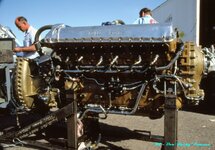MIflyer
1st Lieutenant
Back in 1999 I was writing an article and needed some photos of the back of some engines, where the supercharger is located. I found those are very hard to find. So I flew over to Kissimmee to the O'Reilly restoration facility and museum they had there and took some photos of the Merlin that was out in the open. Tragically, that facility was all but destroyed by Hurricane Charley in 2004 and they moved to Douglas, GA.
The last time I went to Kissimmee was to the Stallion 51 facility for an AOPA seminar. I did not bring a camera, which was really too bad because they have a Merlin there with cut-aways showing the internals. Maybe I'll get back there sometime.
Anyway, some of y'all might find these photos to be interesting.



The last time I went to Kissimmee was to the Stallion 51 facility for an AOPA seminar. I did not bring a camera, which was really too bad because they have a Merlin there with cut-aways showing the internals. Maybe I'll get back there sometime.
Anyway, some of y'all might find these photos to be interesting.
Last edited:















